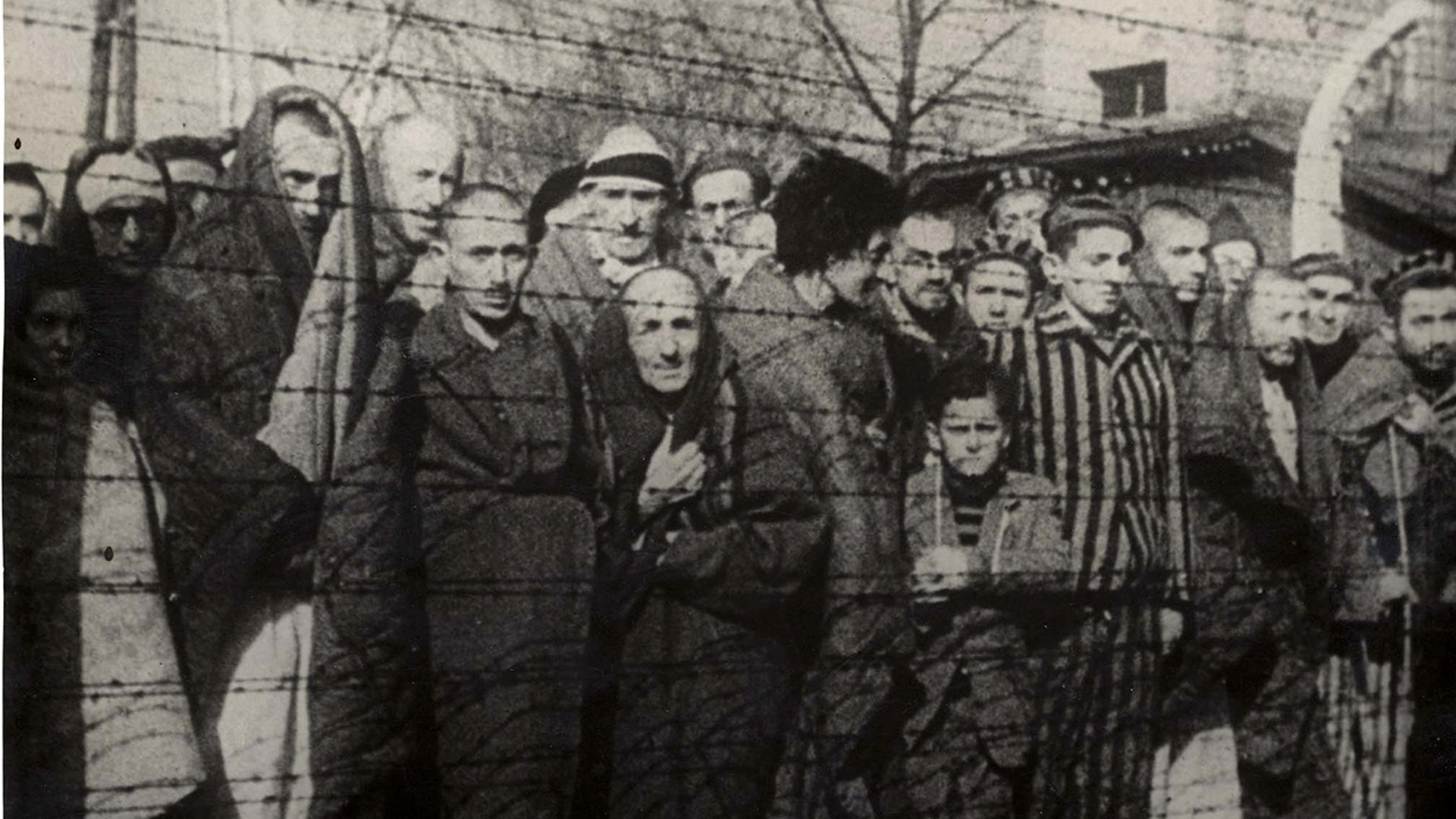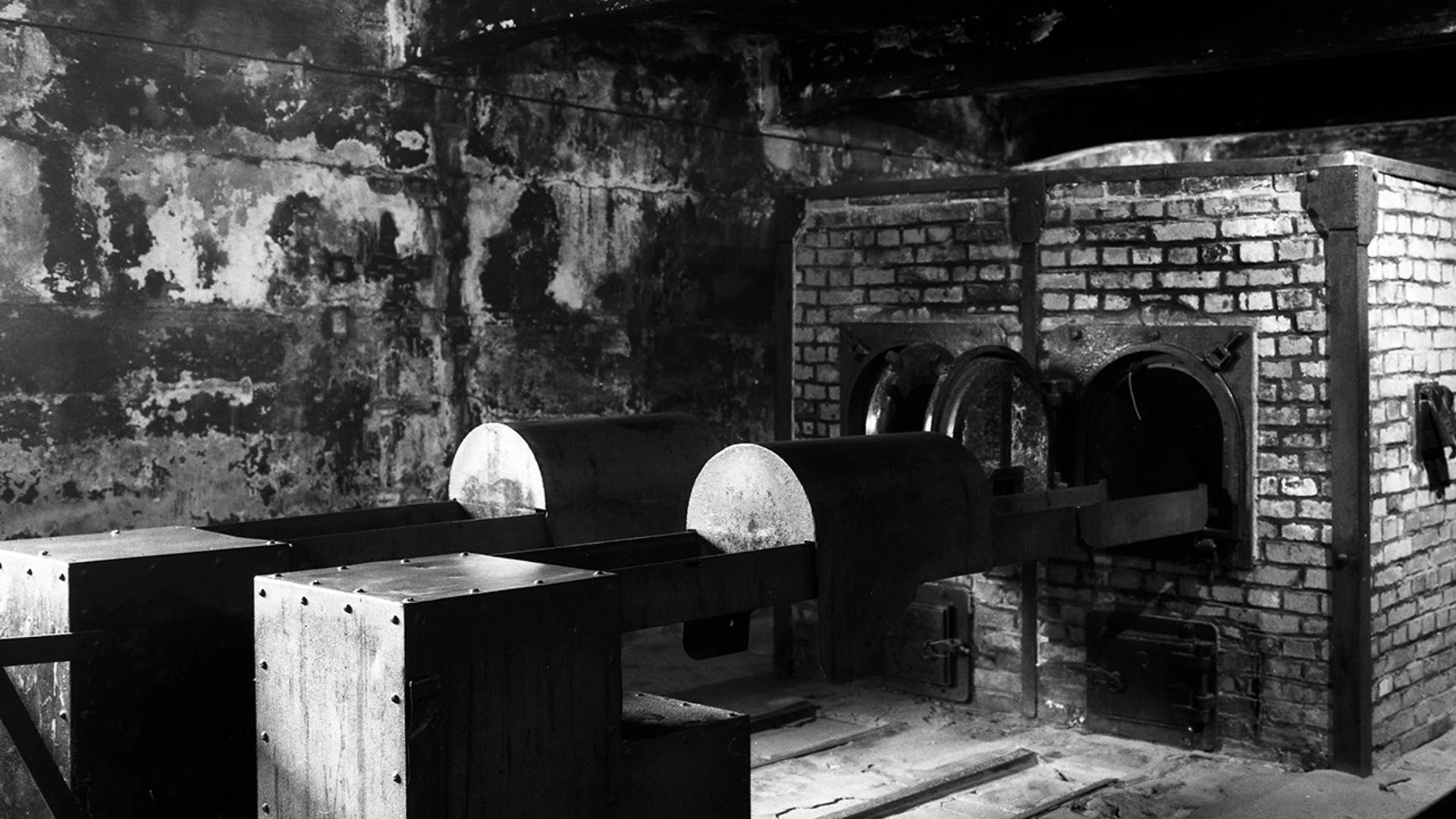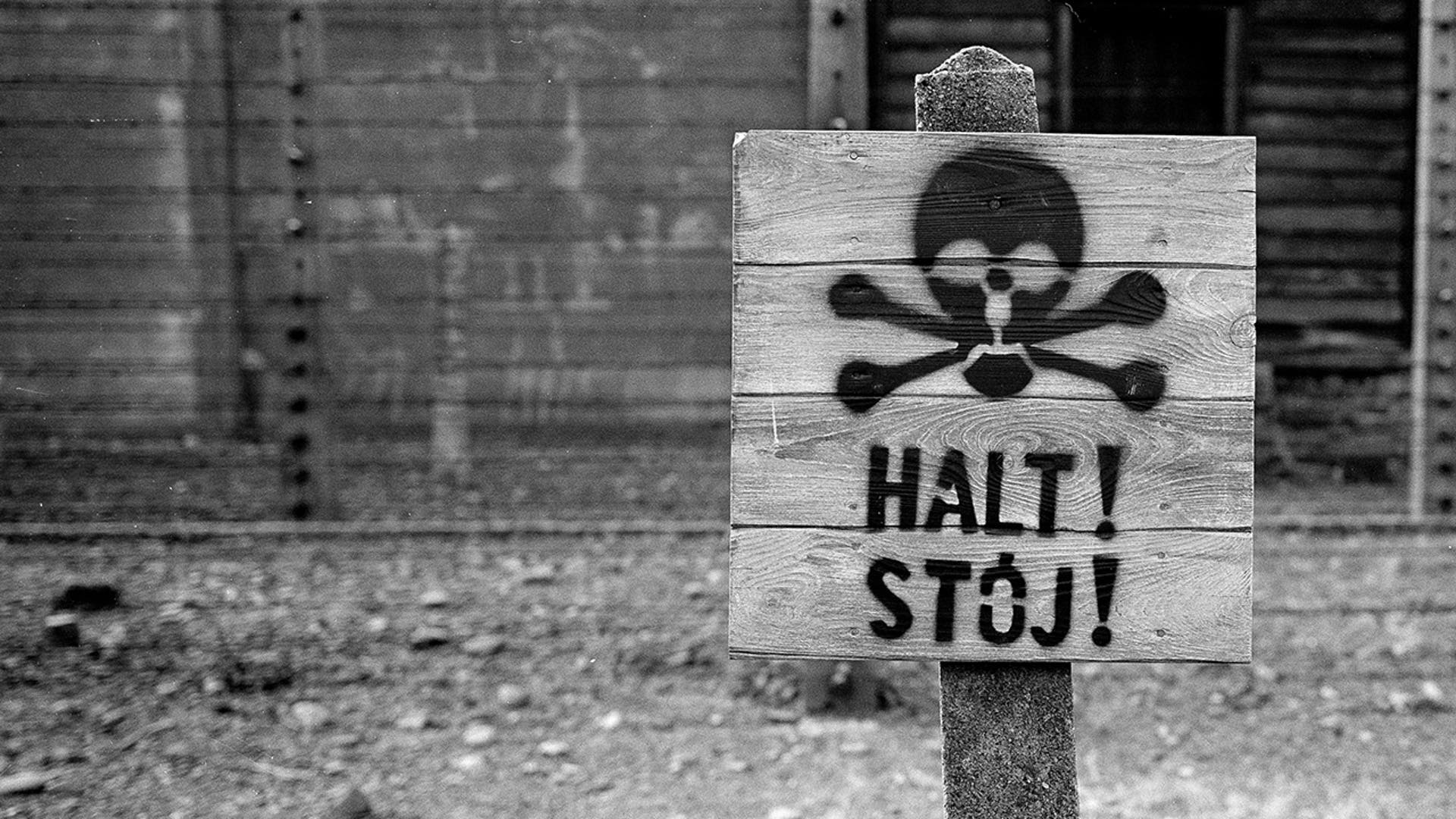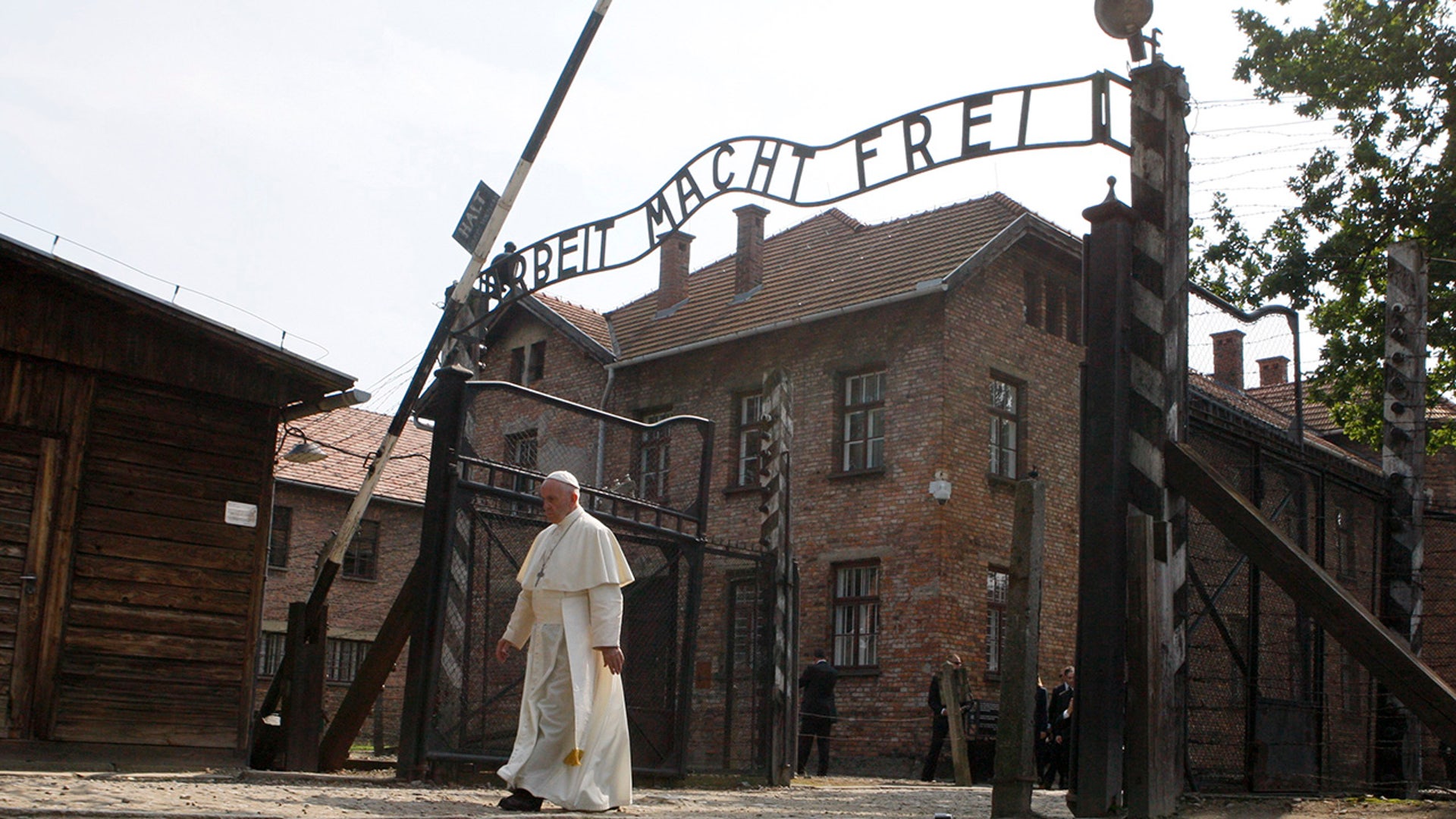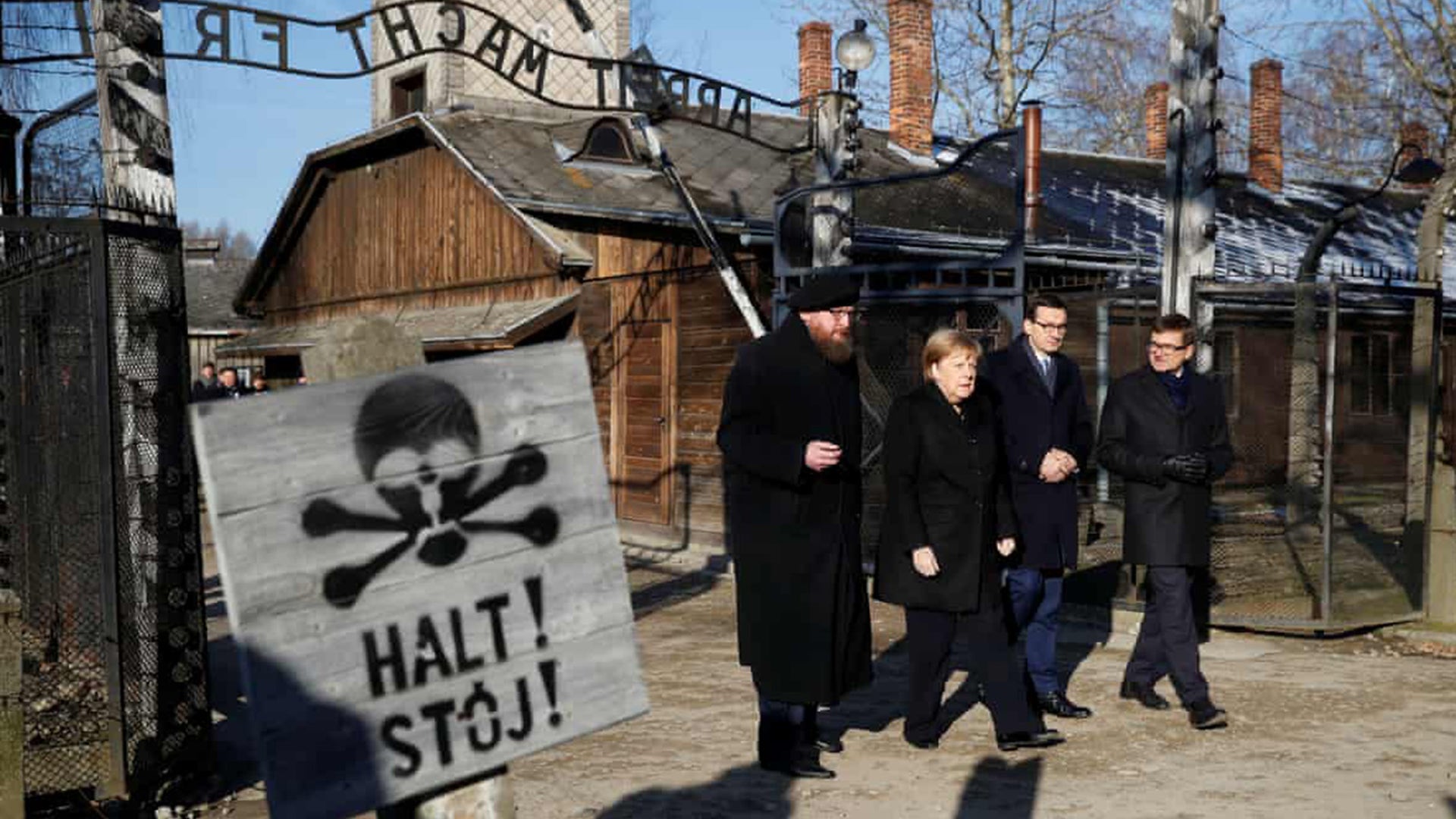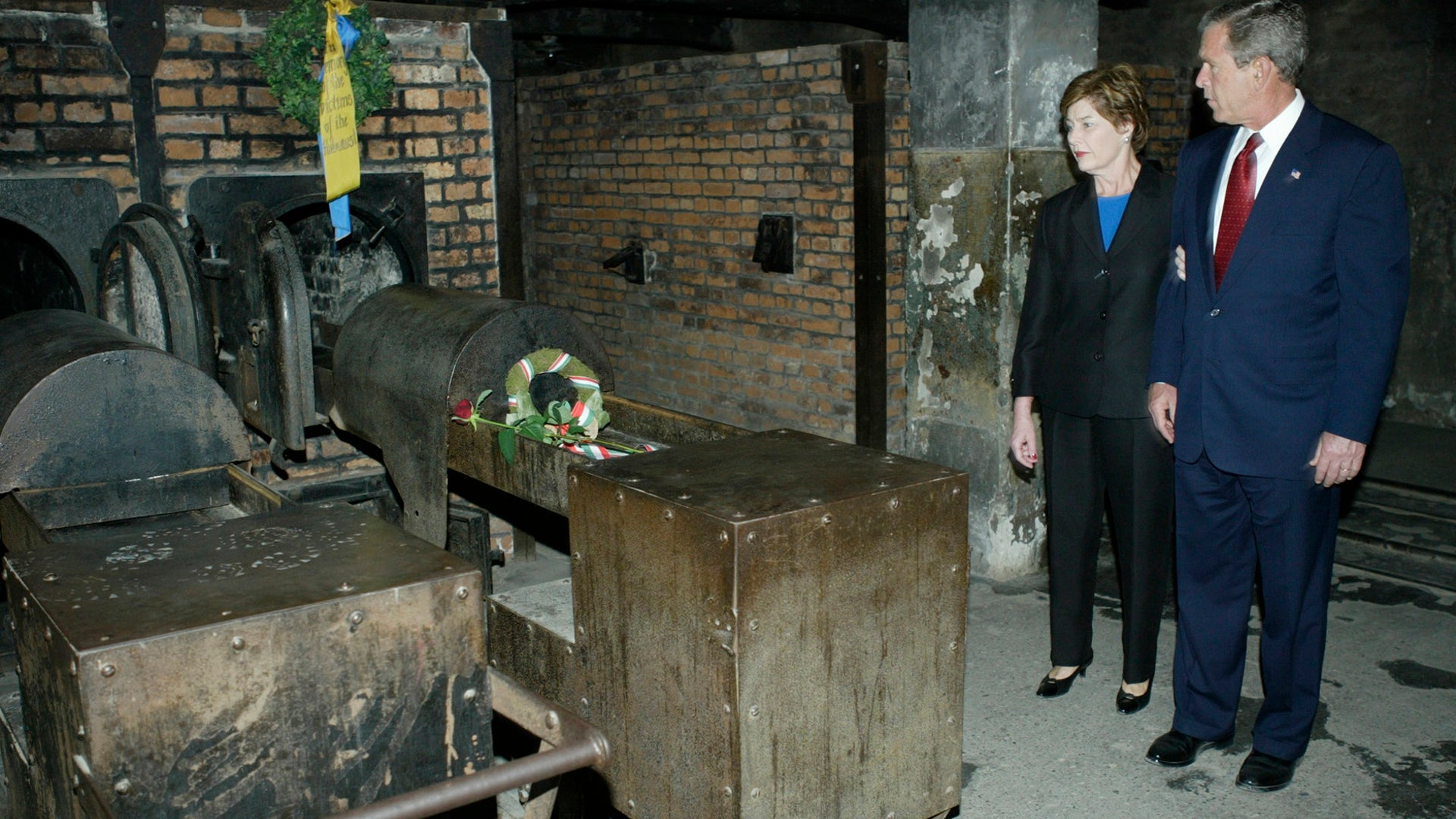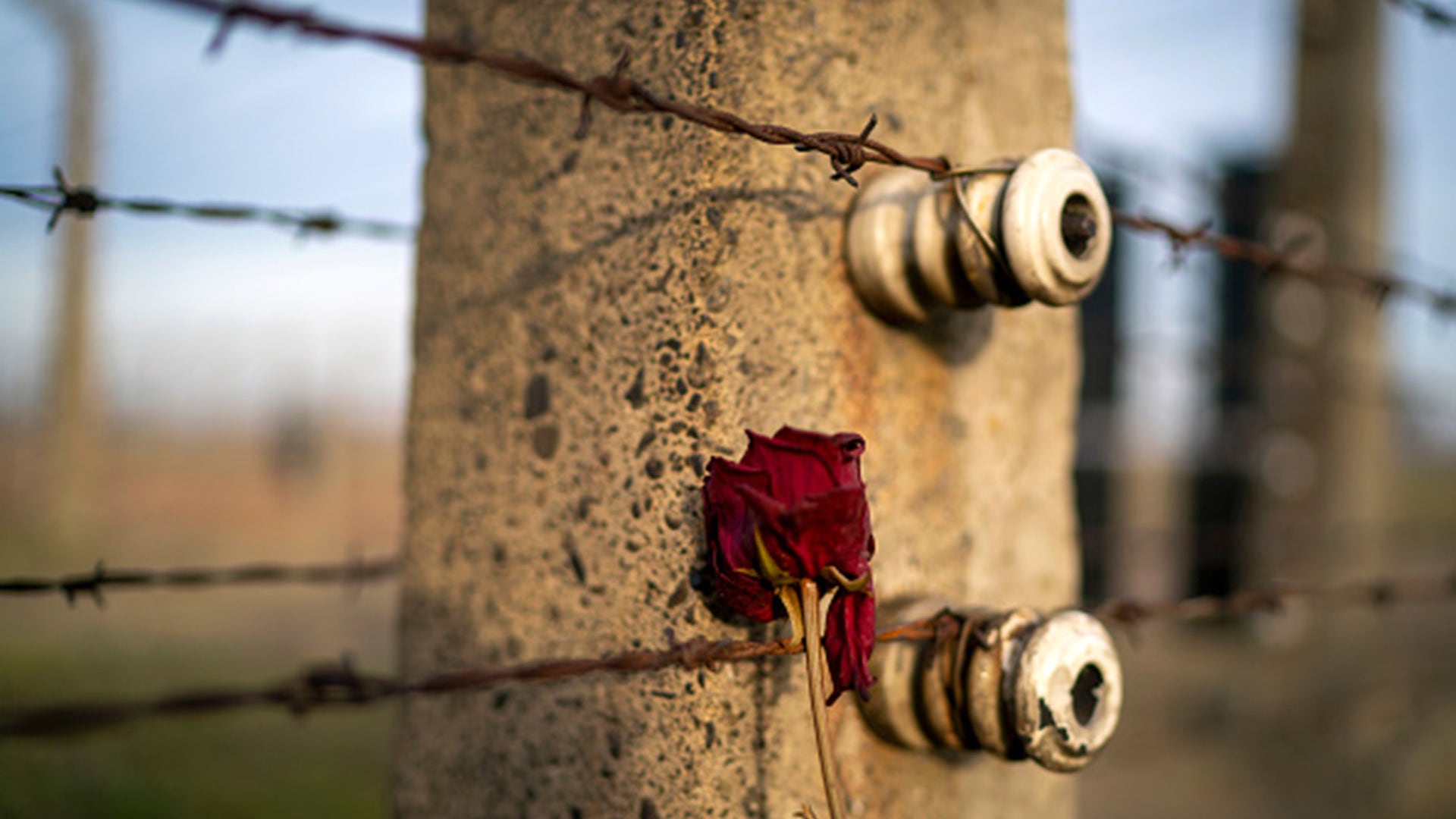Move Back
ADVERTISEMENT
Skip- Published29 Images
Auschwitz-Birkenau anniversary: A look back at 75 years since liberation
Auschwitz was the largest of the Germans' extermination and death camps and has become a symbol for the terror of the Holocaust.
![A group of child survivors behind a barbed wire fence at the Nazi concentration camp at Auschwitz-Birkenau in southern Poland, on the day of the camp’s liberation by the Red Army on Jan. 27, 1945. The photo was taken by Red Army photographer Captain Alexander Vorontsov during the making of a film about the liberation of the camp. The children were dressed in adult uniforms by the Russians. The children are (left to right): Tomy Schwarz (later Shacham), Miriam Ziegler, Paula Lebovics (front), Ruth Webber, Berta Weinhaber (later Bracha Katz), Erika Winter (later Dohan), Marta Weiss (later Wise), Eva Weiss (later Slonim), Gabor Hirsch (just visible behind Eva Weiss), Gabriel Neumann, Robert Schlesinger (later Shmuel Schelach), Eva Mozes Kor, and Miriam Mozes Zeiger.]() A group of child survivors behind a barbed wire fence at the Nazi concentration camp at Auschwitz-Birkenau in southern Poland, on the day of the camp’s liberation by the Red Army on Jan. 27, 1945. The photo was taken by Red Army photographer Captain Alexander Vorontsov during the making of a film about the liberation of the camp. The children were dressed in adult uniforms by the Russians. The children are (left to right): Tomy Schwarz (later Shacham), Miriam Ziegler, Paula Lebovics (front), Ruth Webber, Berta Weinhaber (later Bracha Katz), Erika Winter (later Dohan), Marta Weiss (later Wise), Eva Weiss (later Slonim), Gabor Hirsch (just visible behind Eva Weiss), Gabriel Neumann, Robert Schlesinger (later Shmuel Schelach), Eva Mozes Kor, and Miriam Mozes Zeiger.read moreGetty ImagesShare
A group of child survivors behind a barbed wire fence at the Nazi concentration camp at Auschwitz-Birkenau in southern Poland, on the day of the camp’s liberation by the Red Army on Jan. 27, 1945. The photo was taken by Red Army photographer Captain Alexander Vorontsov during the making of a film about the liberation of the camp. The children were dressed in adult uniforms by the Russians. The children are (left to right): Tomy Schwarz (later Shacham), Miriam Ziegler, Paula Lebovics (front), Ruth Webber, Berta Weinhaber (later Bracha Katz), Erika Winter (later Dohan), Marta Weiss (later Wise), Eva Weiss (later Slonim), Gabor Hirsch (just visible behind Eva Weiss), Gabriel Neumann, Robert Schlesinger (later Shmuel Schelach), Eva Mozes Kor, and Miriam Mozes Zeiger.read moreGetty ImagesShare![A Soviet military doctor examines Holocaust survivors after the liberation of the death camp Auschwitz-Birkenau. Auschwitz was a network of concentration camps built and operated in occupied Poland by Nazi Germany during World War II. Auschwitz I and nearby Auschwitz II-Birkenau was the extermination camp where an estimated 1.1 million people, mostly Jews from across Europe, were killed in gas chambers or from systematic starvation, forced labor, disease and medical experiments.]() A Soviet military doctor examines Holocaust survivors after the liberation of the death camp Auschwitz-Birkenau. Auschwitz was a network of concentration camps built and operated in occupied Poland by Nazi Germany during World War II. Auschwitz I and nearby Auschwitz II-Birkenau was the extermination camp where an estimated 1.1 million people, mostly Jews from across Europe, were killed in gas chambers or from systematic starvation, forced labor, disease and medical experiments.read moreCourtesy of Yad Vashem Archives/Handout via REUTERSShare
A Soviet military doctor examines Holocaust survivors after the liberation of the death camp Auschwitz-Birkenau. Auschwitz was a network of concentration camps built and operated in occupied Poland by Nazi Germany during World War II. Auschwitz I and nearby Auschwitz II-Birkenau was the extermination camp where an estimated 1.1 million people, mostly Jews from across Europe, were killed in gas chambers or from systematic starvation, forced labor, disease and medical experiments.read moreCourtesy of Yad Vashem Archives/Handout via REUTERSShare![Jews wearing Star of David badges in the Lodz Ghetto, Poland, sometime during World War II. The Nazis forced Jews into overcrowded ghettos from where thousands were deported to the death camps.]()
![Undated photo of Holocaust survivors are seen behind a barbed wire fence after the liberation in 1945 of the Auschwitz-Birkenau death camp in Nazi-occupied Poland.]()
![Auschwitz was the largest of the Germans' extermination and death camps and has become a symbol for the terror of the Holocaust.]()
![The crematorium near gas chamber one at the former Nazi death camp of Auschwitz I in Oswiecim, Poland, seen on Dec. 8, 2019. On Jan. 27, 1945, the Soviet Red Army liberated the Auschwitz death camp in German-occupied Poland.]()
![Inmates are seen lying on bunks in a barrack at Nazi German death camp Auschwitz-Birkenau after its liberation in 1945 in Nazi-occupied Poland.]()
![An observation tower still stands inside the former Nazi death camp of Auschwitz Birkenau or Auschwitz II in Oswiecim, Poland.]()
![A December 2019 view inside a prisoner barracks in the former Nazi death camp of Auschwitz Birkenau or Auschwitz II in Oswiecim, Poland.]()
![The remains of the brick stone chimneys of prisoner barracks can be seen inside the former Nazi death camp of Auschwitz Birkenau or Auschwitz II in Oswiecim, Poland, on Dec. 8, 2019.]()
![A wagon still stands on the railway tracks from where hundred thousands of people were directed to the gas chambers to be murdered inside the former Nazi death camp of Auschwitz Birkenau or Auschwitz II, in Oswiecim, Poland.]()
![The remains of brick stone chimneys of prisoner barracks can be seen inside the former Nazi death camp of Auschwitz Birkenau or Auschwitz II. in Oswiecim, Poland. On Dec. 27, 2020, 75 years after its liberation, hundreds of survivors from across the world will come back to visit Auschwitz for official anniversary commemorations.]() The remains of brick stone chimneys of prisoner barracks can be seen inside the former Nazi death camp of Auschwitz Birkenau or Auschwitz II. in Oswiecim, Poland. On Dec. 27, 2020, 75 years after its liberation, hundreds of survivors from across the world will come back to visit Auschwitz for official anniversary commemorations.read moreAP Photo/Markus SchreiberShare
The remains of brick stone chimneys of prisoner barracks can be seen inside the former Nazi death camp of Auschwitz Birkenau or Auschwitz II. in Oswiecim, Poland. On Dec. 27, 2020, 75 years after its liberation, hundreds of survivors from across the world will come back to visit Auschwitz for official anniversary commemorations.read moreAP Photo/Markus SchreiberShare![A wooden sign with the word STOP stands in front of what was an electric barbed wire fence inside the former Nazi death camp of Auschwitz I, in Oswiecim, Poland, in a photo taken on Dec. 8, 2019.]()
![The railway tracks that took hundreds of thousands of people to gas chambers to be murdered, inside the former Nazi death camp of Auschwitz-Birkenau, in German-occupied Poland.]()
![The same railway tracks today, inside the former Nazi death camp of Auschwitz. World leaders will gather twice to mark the 75th anniversary of the liberation of the Auschwitz-Birkenau concentration camp — once on Thursday, Jan. 23, 2020, in Jerusalem and again on Jan. 27 at the Auschwitz site in southern Poland. The fact that there will be two competing ceremonies reflects how politically charged World War II remains for nationalist governments in Russia and Poland.]() The same railway tracks today, inside the former Nazi death camp of Auschwitz. World leaders will gather twice to mark the 75th anniversary of the liberation of the Auschwitz-Birkenau concentration camp — once on Thursday, Jan. 23, 2020, in Jerusalem and again on Jan. 27 at the Auschwitz site in southern Poland. The fact that there will be two competing ceremonies reflects how politically charged World War II remains for nationalist governments in Russia and Poland.read moreAP Photo/Markus Schreiber, FileShare
The same railway tracks today, inside the former Nazi death camp of Auschwitz. World leaders will gather twice to mark the 75th anniversary of the liberation of the Auschwitz-Birkenau concentration camp — once on Thursday, Jan. 23, 2020, in Jerusalem and again on Jan. 27 at the Auschwitz site in southern Poland. The fact that there will be two competing ceremonies reflects how politically charged World War II remains for nationalist governments in Russia and Poland.read moreAP Photo/Markus Schreiber, FileShare![An auxiliary Jewish police force keeps order in the Lodz Ghetto, which was used by the Germans to organize the selection of people for deportation.]()
![The main entrance at the former Nazi death camp of Auschwitz in Oswiecim, Poland, with the inscription, "Arbeit Macht Frei," which translates into English as '"Work sets you free," pictured on Dec. 8, 2019.]()
![Then-president of the World Jewish Congress Ronald Lauder stands near the lettering "Arbeit macht frei" ("Work sets you free") hanging at the entrance gate of the former Auschwitz concentration camp held by the Nazis during WWII in Oswiecim on Jan. 26, 2015.]() Then-president of the World Jewish Congress Ronald Lauder stands near the lettering "Arbeit macht frei" ("Work sets you free") hanging at the entrance gate of the former Auschwitz concentration camp held by the Nazis during WWII in Oswiecim on Jan. 26, 2015.read moreODD ANDERSEN/AFP via Getty Images)Share
Then-president of the World Jewish Congress Ronald Lauder stands near the lettering "Arbeit macht frei" ("Work sets you free") hanging at the entrance gate of the former Auschwitz concentration camp held by the Nazis during WWII in Oswiecim on Jan. 26, 2015.read moreODD ANDERSEN/AFP via Getty Images)Share![Pope Francis walks through a gate with the words "Arbeit macht frei" ("Work sets you free") at the former Nazi German concentration and extermination camp Auschwitz-Birkenau in Oswiecim, Poland, July 29, 2016.]()
![Angela Merkel and the Polish Prime Minister Mateusz Morawiecki at Auschwitz in Poland.]()
![U.S. President George W. Bush and first lady Laura Bush tour the Auschwitz Crematorium in Osweicim, southern Poland.]()
![Nazi concentration camp survivor Jerry Wartski, who now lives in the U.S., stands behind the memorial during the commemoration ceremonies for the 73th anniversary of the liberation of former Nazi concentration camp Mittelbau-Dora near Nordhausen, Germany, on April 11, 2018.]() Nazi concentration camp survivor Jerry Wartski, who now lives in the U.S., stands behind the memorial during the commemoration ceremonies for the 73th anniversary of the liberation of former Nazi concentration camp Mittelbau-Dora near Nordhausen, Germany, on April 11, 2018.read moreAP Photo/Jens MeyerShare
Nazi concentration camp survivor Jerry Wartski, who now lives in the U.S., stands behind the memorial during the commemoration ceremonies for the 73th anniversary of the liberation of former Nazi concentration camp Mittelbau-Dora near Nordhausen, Germany, on April 11, 2018.read moreAP Photo/Jens MeyerShare![Holocaust survivor Naftali Furst stands next to his portrait during the opening of the exhibition 'Survivors - Faces of Life after the Holocaust' at the former coal mine Zollverein in Essen, Germany, on Jan. 21, 2020.]()
![Auschwitz survivor Agi Geva poses for a photo at the Holocaust Memorial Museum in Washington, D.C., on Jan. 16, 2020, ahead of commemorations marking the 75th anniversary of the liberation of Auschwitz by the Soviet army.]()
![In this Wednesday, Jan. 8, 2020 photo Auschwitz survivor Eva Umlauf shows her tattoed arm as she poses for a photo in Munich, Germany.]()
![Holocaust and Auschwitz survivor Leon Schwarzbaum shows his tattooed identification number in his home in Berlin on Jan. 4, 2020.]()
![German chancellor Angela Merkel stands in front of a portrait of Holocaust survivor Naftali Furst during the opening of the exhibition "Survivors - Faces of Life after the Holocaust" at the former coal mine Zollverein in Essen, Germany, on Jan. 21, 2020. The industrial world heritage landmark Zollverein is showing an exhibition of 75 portraits of Jewish survivors, photographed in Israel by German artist Martin Schoeller.]() German chancellor Angela Merkel stands in front of a portrait of Holocaust survivor Naftali Furst during the opening of the exhibition "Survivors - Faces of Life after the Holocaust" at the former coal mine Zollverein in Essen, Germany, on Jan. 21, 2020. The industrial world heritage landmark Zollverein is showing an exhibition of 75 portraits of Jewish survivors, photographed in Israel by German artist Martin Schoeller.read moreAP Photo/Martin MeissnerShare
German chancellor Angela Merkel stands in front of a portrait of Holocaust survivor Naftali Furst during the opening of the exhibition "Survivors - Faces of Life after the Holocaust" at the former coal mine Zollverein in Essen, Germany, on Jan. 21, 2020. The industrial world heritage landmark Zollverein is showing an exhibition of 75 portraits of Jewish survivors, photographed in Israel by German artist Martin Schoeller.read moreAP Photo/Martin MeissnerShare![Visitors look at portrait photos of the exhibition "Survivors - Faces of Life after the Holocaust" at the former coal mine Zollverein in Essen, Germany, on Jan. 21, 2020.]()
![A memorial rose sits on the electric fence of the Auschwitz II-Birkenau extermination camp on Dec. 19, 2019 in Oswiecim, Poland. Ceremonies marking the 75th anniversary of the liberation of the camp by Soviet soldiers are due to take place on Jan. 27, 2020.]() A memorial rose sits on the electric fence of the Auschwitz II-Birkenau extermination camp on Dec. 19, 2019 in Oswiecim, Poland. Ceremonies marking the 75th anniversary of the liberation of the camp by Soviet soldiers are due to take place on Jan. 27, 2020.read moreChristopher Furlong/Getty ImagesShare
A memorial rose sits on the electric fence of the Auschwitz II-Birkenau extermination camp on Dec. 19, 2019 in Oswiecim, Poland. Ceremonies marking the 75th anniversary of the liberation of the camp by Soviet soldiers are due to take place on Jan. 27, 2020.read moreChristopher Furlong/Getty ImagesShare- Published29 Images
Auschwitz-Birkenau anniversary: A look back at 75 years since liberation
Auschwitz was the largest of the Germans' extermination and death camps and has become a symbol for the terror of the Holocaust.
Move Forward
- Auschwitz-Birkenau anniversary: A look back at 75 years since liberation





























Thumbnail View
Image 0 of 29




